Blog
March 2nd, 2010
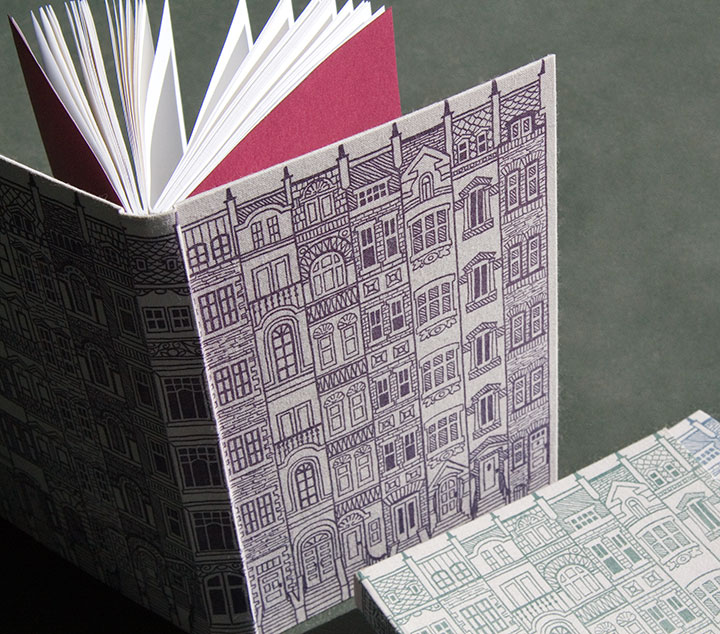
Allison of Igloo Letterpress and I have been doing some more cross-country collaboration lately. This time I illustrated a set of hand-bound journals featuring a pattern of Brownstones—one of my favorite types of houses, and a recurring theme in my drawings.

I’m so lucky to work with Allison—despite the distance, and the fact that we haven’t seen each other for two years, I feel like I we’re on the same wavelength. I love the fact that we can trust each other to make independent creative decisions, and have faith that they’ll come together into a harmonious whole. But my part of the project is finished when I send her black-and-white illustrations for printing—since I can’t exactly pop into her shop whenever I want, I really have no idea how the finished product will look until she sends it to me.

So imagine my delight when a package arrived containing four beautifully-bound hardcover books, with my illustration splashed on the cover in gorgeous color—
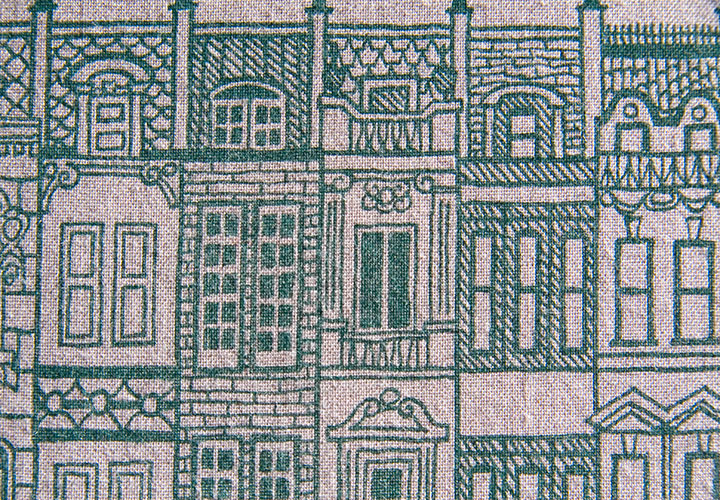
—and printed right onto the book cloth, no less!
I did a little hopping dance around the living room after that.
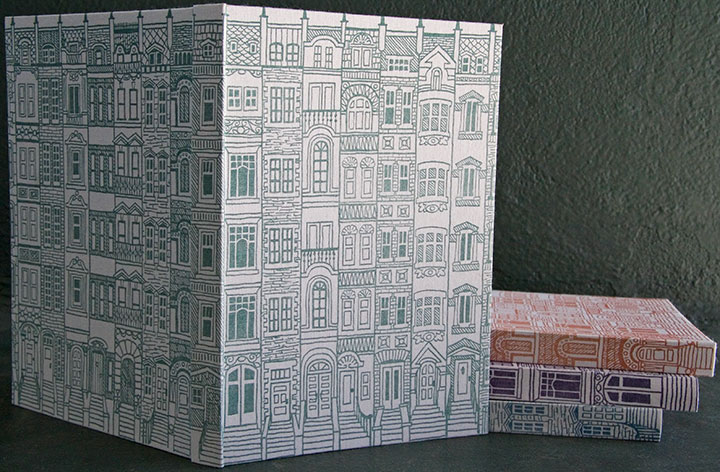
Here’s the best part, and a flash of Allison’s brilliance: not only do the books fit together thematically, but when they stand together on a bookshelf, the spines line up to complete the picture.
Since these are so labor-intensive to make, Allison is offering them only as a limited edition. But they’ve already been a big hit so far—which makes everything so, so satisfying.
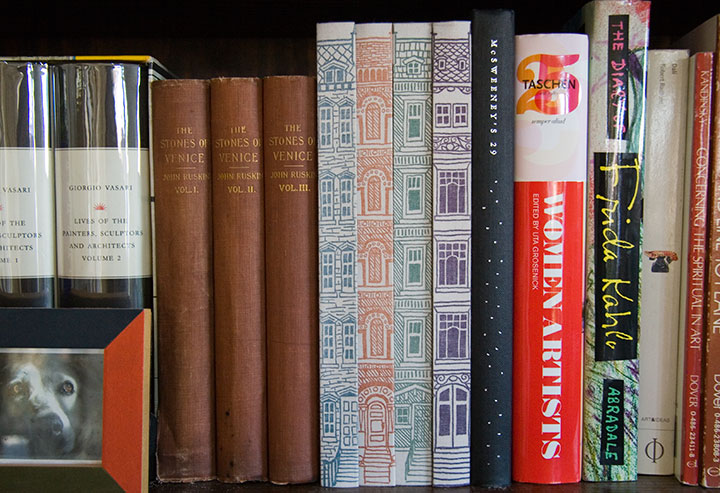
January 30th, 2010
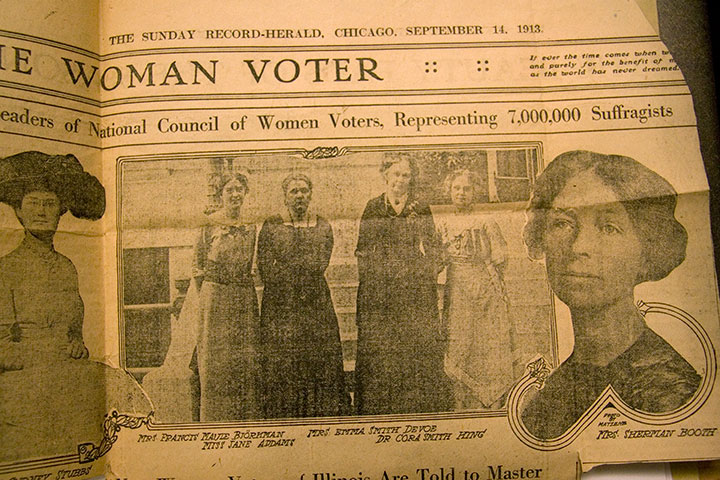
It’s just about that time again: Jessica and I are working hard on the next Dead Feminist broadside. She’s poring through texts and historical facts, and I’m pencilling as fast as my tendonitis will let me. This time we’ll be unveiling the new piece at the Washington State Library near Olympia; the staff invited us to give a lecture about the series next month.
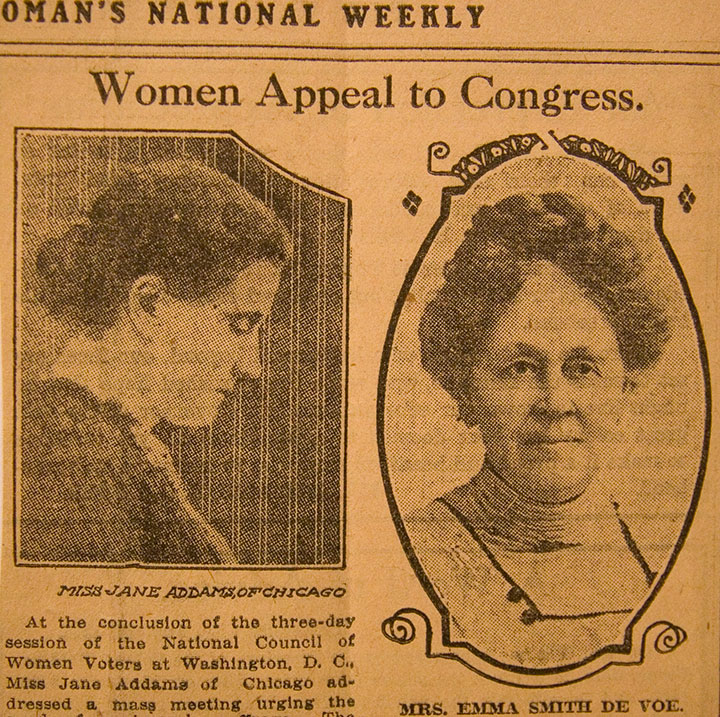
The library boasts the entire collection of letters and personal papers of Emma Smith DeVoe (pictured above, right), women’s rights activist and leader of the Washington suffragist movement. And since this year marks the 100th anniversary of women’s suffrage in Washington, we figured Emma would be a perfect fit for the new piece.
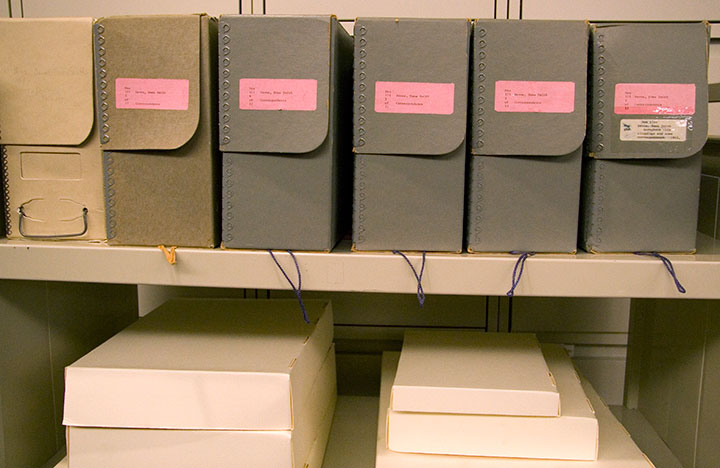
So a couple of weeks ago, Jessica, Zooey (R.I.P., J.D. Salinger) and I took a field trip to visit the archives and conduct a little research. When we arrived, we realized what they meant by “collection:” twelve enormous boxes packed full of letters, clippings and souvenirs. A “little” research obviously wasn’t going to happen.
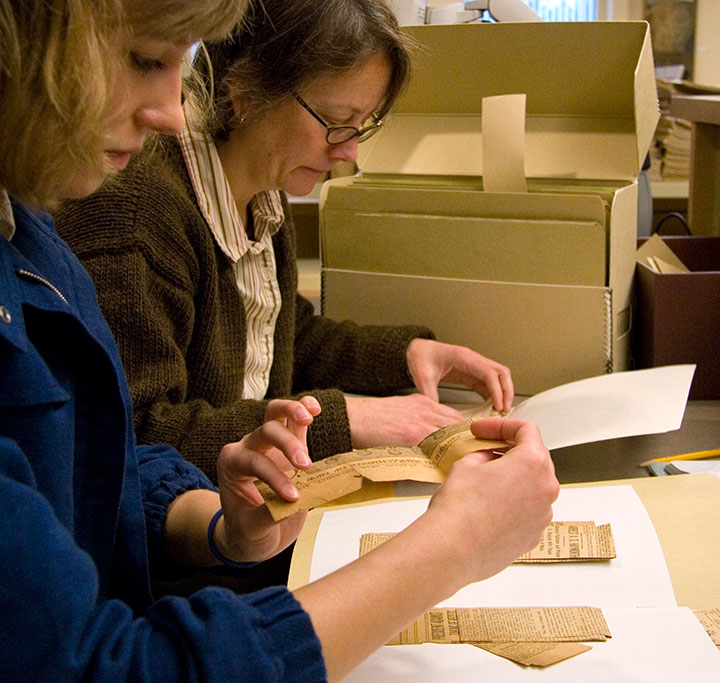
Luckily, the incredibly knowledgeable and helpful library staff (thank you, Sean!) let us take as much time and as many photos as we needed. So we cozied up to a work station and dived in, one box at a time. Together we went through literally thousands of pieces of paper.
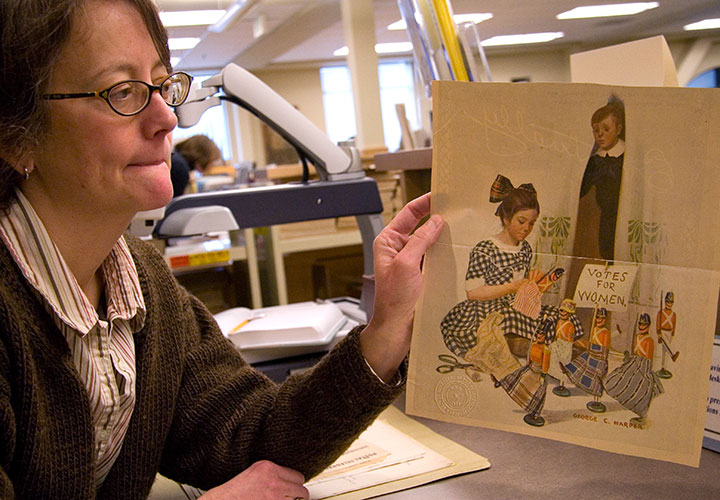
What we found was a fascinating collection of souvenirs, business cards, newspaper clippings,

leaflets and other propaganda,
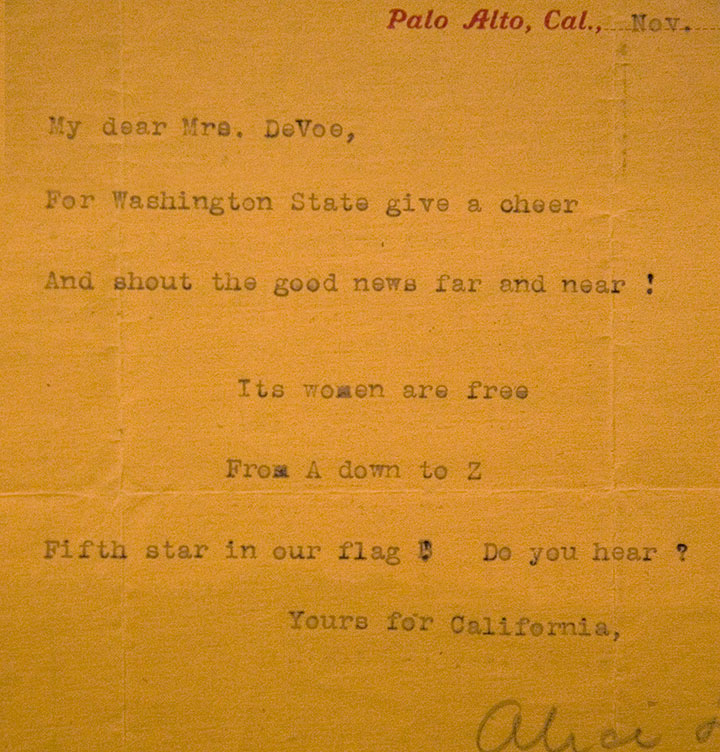
fan letters (Emma had an impressive array of admirers),
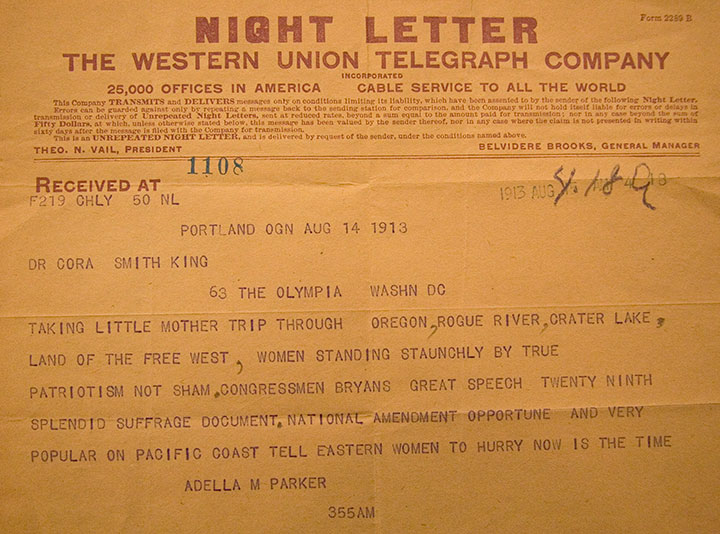
telegrams, notes from sitting U.S. senators and presidential aides, and reams and reams of correspondance between the members of the Washington suffragist movement.
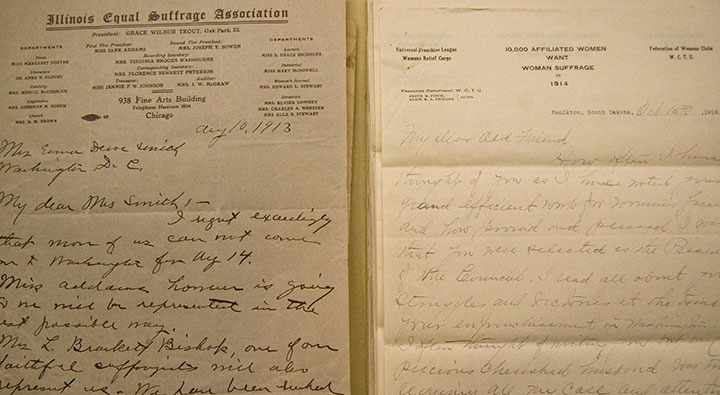
The trouble was, most of these documents were utterly mundane—letter after letter simply acknowledged receipt of previous correspondance, or gave detailed instructions for planning events and delegating tasks. Worst of all, Emma rarely made carbon copies of her half of the correspondance, so there was very little in her own voice.
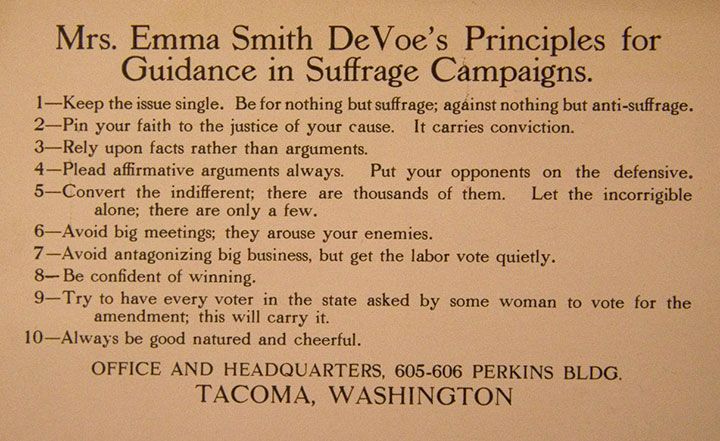
We spent nearly four hours poring over every folder and box, and the only potential Emma quotes we found were mined from this instructional card. Still, it didn’t feel like we had found our inspiration—just a few weeks from our talk, we had no quote and no social topic for the piece.
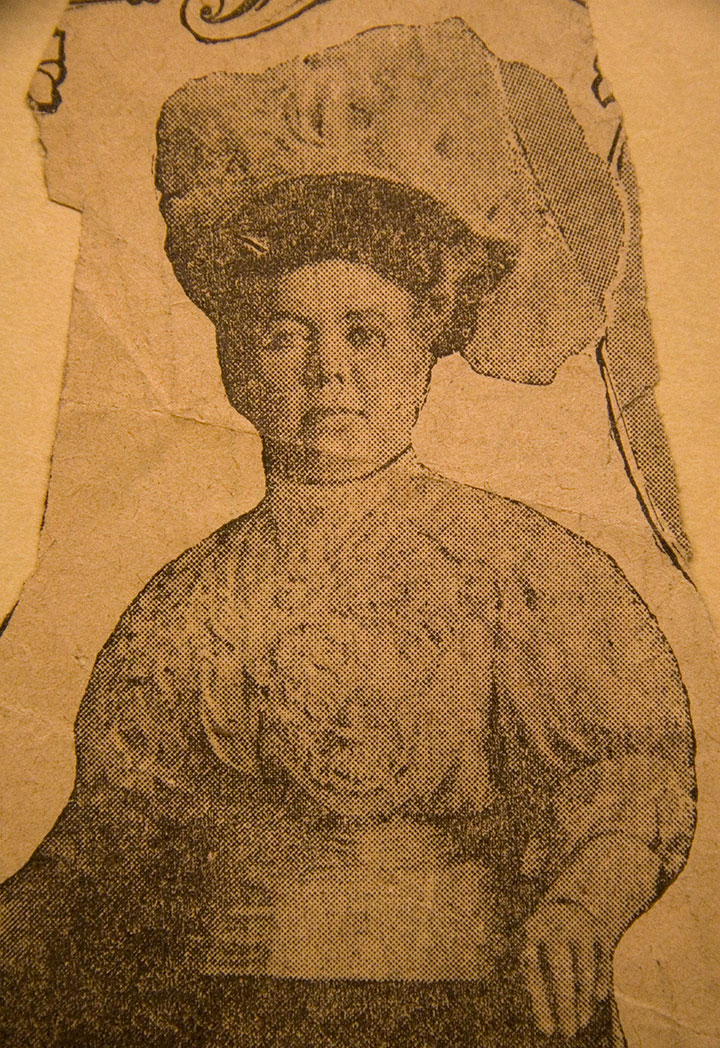
What we did have, however, was a much clearer picture of the women behind the fight for suffrage in our state (that’s May Arkwright Hutton above; she and Emma didn’t exactly get along), right down to addresses of homes and buildings still standing in Tacoma (the headquarters of the movement).
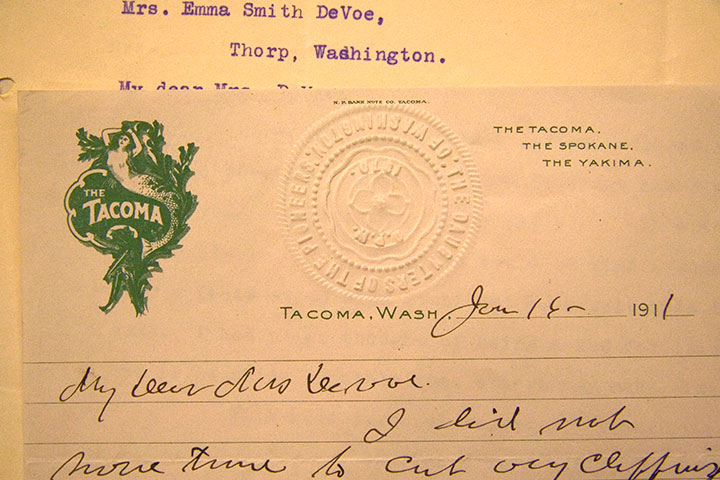
From the documents themselves to the individual script hands of each letter writer, we had an incredible window into political life from a hundred years ago.
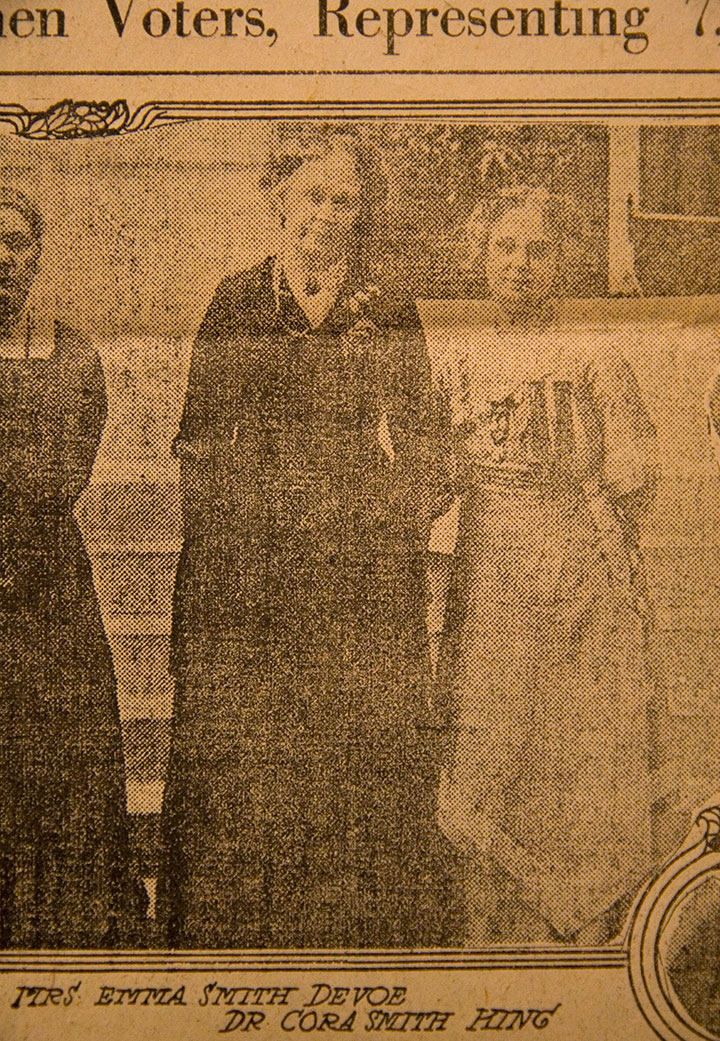
And we found a good lead. Just as interesting as Emma (and more forthcoming with their own voices) were Cora Smith Eaton King, M.D. (pictured above, right)—correspondent, fellow leader of the movement, and one of the first women to scale Mt. Rainier!—and Bernice Sapp—friend, activist, and the one who compiled this collection of documents and donated it to the library.
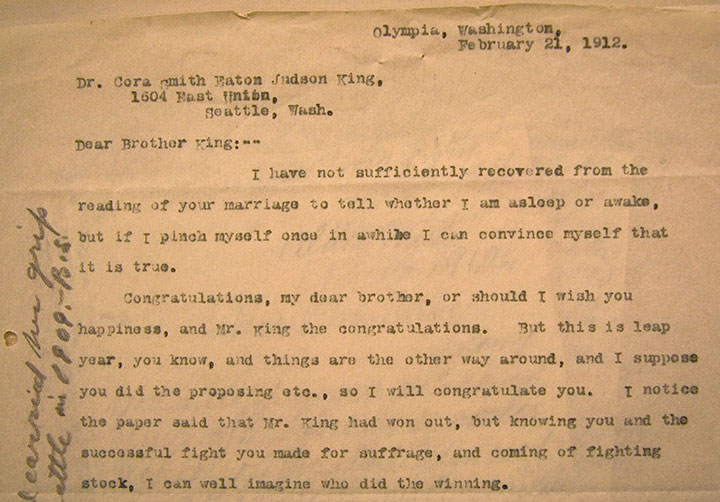
Bernice’s letters were full of quirky character and wit. We loved how she called Emma “the General,” and referred to herself and other suffragists by male titles: “Brother King,” “Mr. Hutton,” or simply “him.”
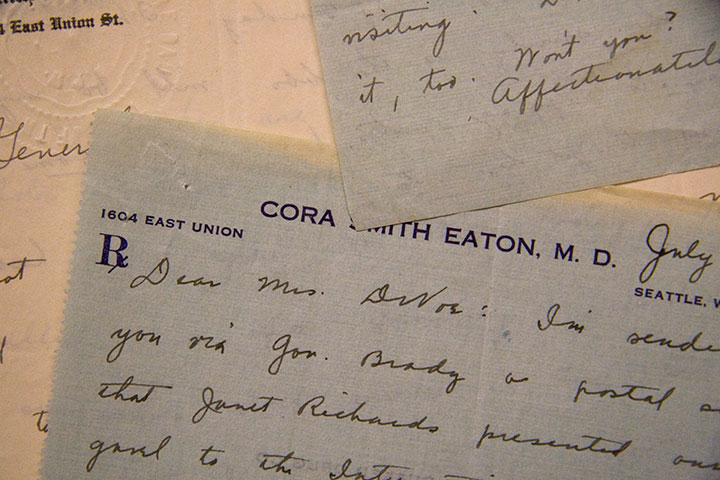
Cora, on the other hand, was a real firecracker. Her letters (often scribbled on scraps of paper, even her own prescription pad!) revealed an eloquent intelligence and a sizzling sense of humor. We fell head-over-heels for Cora, and began to doubt that Emma was the right voice for the broadside—still, though, we had no quote from any of these women.
A few days later, Jessica hit up the astounding Northwest Room at the Tacoma Public Library, and hit the jackpot. She discovered a document that linked all of these women together, which decided us on a slightly different approach to quoting historical feminists. That’s all I’ll say for now, except that the new broadside may or may not depict a certain quivering, questionable “food” substance:

If you want to be one of the first to see what the heck I’m talking about, I invite you to come check out our talk at the Washington State Library. Here are the details:
Pressing Matters: an evening with Chandler O’Leary and Jessica Spring
Wednesday, February 10, 2010
6:30 p.m. (doors open at 6:00), free!
Washington State Library
6880 Capitol Boulevard, Tumwater, WA
Libraries and archives face a tough reality in the current economy—especially here in Washington, where a regressive tax system has left the State Library with a 30% staff reduction and major cuts to its operating and acquisitions budgets. The 2003 earthquake damaged their building on the historic capital campus in Olympia, and forced them to relocate “temporarily” to a suburban office park a few miles south in Tumwater. Even when the economy recovers, it is unlikely the library’s funding will return to the levels it enjoyed in more prosperous eras, so the move to Tumwater is looking increasingly permanent. Despite these setbacks, the State Library continues to acquire new items (including our artwork!) for the collection and provide an essential service in preserving our state’s history. So please come and show your support for the library—a good turnout will help them provide more public events in the future, and might just go a long way toward saving them from another visit to the chopping block.
January 26th, 2010
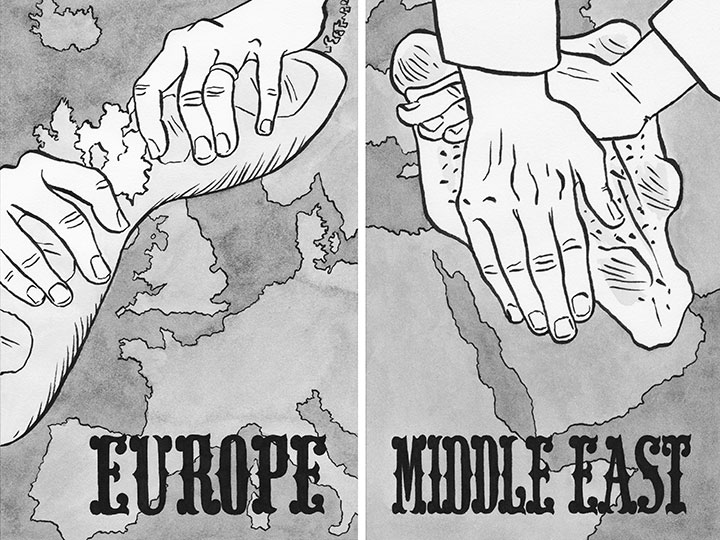
I’m currently working on the illustrations for a cookbook being published this year, so I’m drawing a whole lot of hands lately. Hands carrying dishes, maneuvering chopsticks, folding samosas, kneading dough, etc.

Since I usually work by myself, I often have to be my own model. For the most part, this works out fine, but hands are a tricky business—especially when you need to draw both hands at once, and you need one to operate a pencil.

Enter the lovely Zooey—who could both photograph my hands for me and be hand model herself. We took turns ripping a baguette to shreds for the camera (to mix up the hand anatomy), and mimed with nearly every dish in the house, just in case.
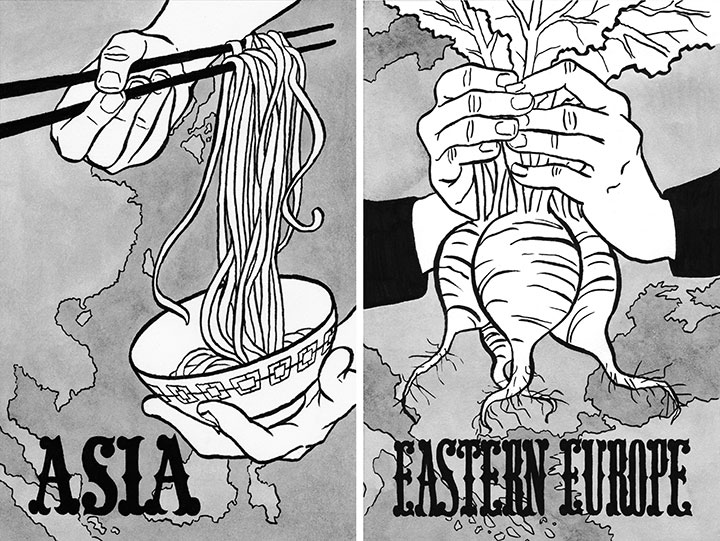
I can’t tell you how helpful it’s been to have her here while I’ve been doing these illustrations. Whenever something wasn’t quite right, I could say, “Hey, Zooey, can you pick up those chopsticks again? I need to sketch a different angle.” And Bob’s your uncle, I’d get what I needed.
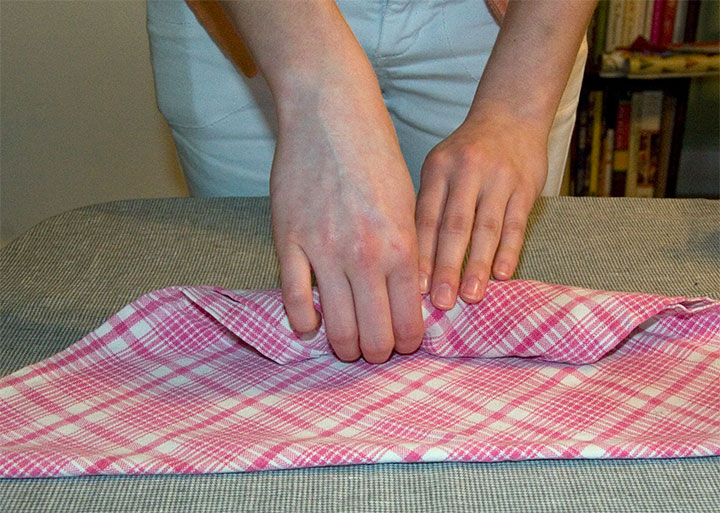
This week we spent a couple of afternoons shooting reference photos. Zooey rolled and unrolled pretend spring rolls made of fabric and made “samosas” with a scrap of denim.
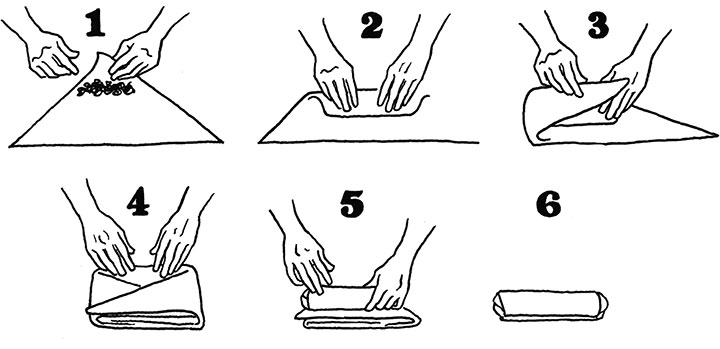
It was probably tedious for her, but the end result was a bunch of instructional illustrations that actually made sense!
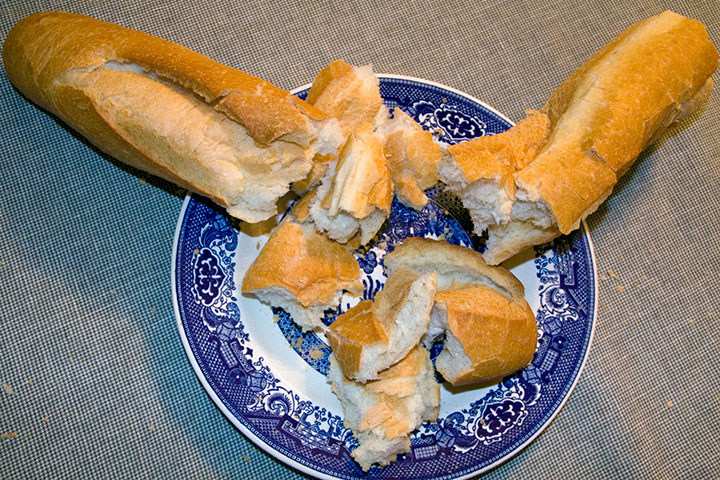
And we made a mess of the bread (doesn’t make it taste any less good!), but Zooey can say she has some pretty, uh, unique on-the-job training under her belt.
• • • • • • • • • • • • • • • • • • • • • • • • • • • • • • • • • • • • • • • • • • • • • • • • • • • • • • • • • • • •
In other news, I did a little website tweaking over the weekend, and added an F.A.Q. (it makes me giggle to pronounce it “Fack.”) If you ever wondered what I mean about half the things I say around here (and judging by the volume of questions I get on a nearly daily basis, you might), go and check it out here—it’s a whopper.
It ended up being a lot of fun to write, because I got to play the part of the snarky interrogator (not that I get many of those, but it’s fun to write like one). I did practice some restraint, however; I was tempted to include a question I get more often than I’d like to admit: “Wait, aren’t you a guy?” True story. Sigh.
Also in the running was “Will you print 1000 coffee mugs with ‘World’s Number One Dad’ for me?” Because I really did get that email once, along with quite a few others mistaking my business for something entirely different. Maybe this will clear things up just a bit…
January 10th, 2010

I find I’m spending more time at the drafting table these days, and far fewer hours chained to the computer. This month I am blessed with an assistant—a brilliant young woman who is helping me with my administrative and production work, in exchange for school credit, a little professional experience and the chance to beef up her design software skills.
We’re lucky to have here in T-town an arts-magnet public high school, and part of the curriculum for juniors and seniors is an internship opportunity during the winter term. I was completely ignorant of this until I received Zooey’s email last fall, asking if I would be willing to take her on. I almost turned her down, simply because I couldn’t imagine I’d have enough to keep her busy and interested for three 40-hour weeks.
But then it occurred to me that I might be able give her an accurate idea of what it’s actually like to make one’s living as a full-time artist—which largely consists of being one’s own secretary, account manager, bean-counter, marketing department, production assistant and gopher, as well as coming up with all the creative ideas. That’s something I wish I had known as a student, and yet was certainly never taught in art school.
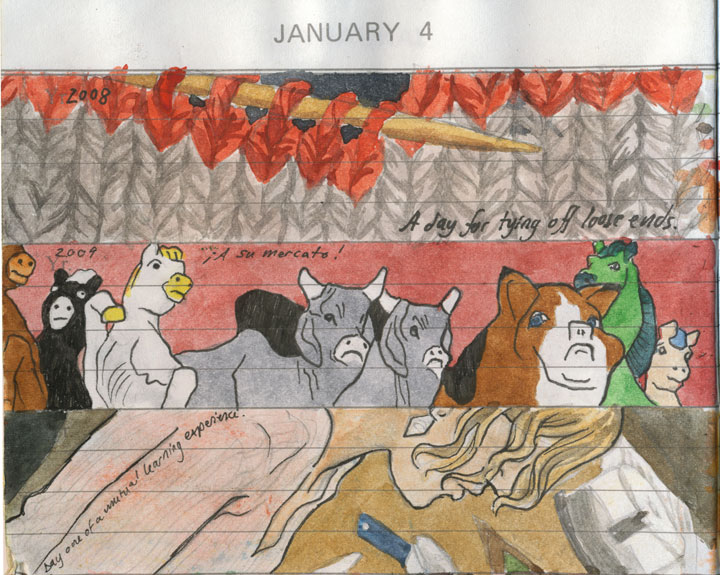
As it turns out, there’s plenty of work for both of us, and it’s been a mutual learning experience. Zooey (not her real name, in keeping with my little privacy policy) is picking up design skills they aren’t teaching at the high school level, attending client meetings and press checks, learning the ins and outs of seeing a project from concept to completion, and contributing her own ideas to creative discussions and brainstorming sessions. And I’m able to spend more time actually creating artwork, rather than endlessly playing catch-up with back-burner projects that should have been done months ago (although I crossed my heart and made her a solemn vow that I would get my own damn coffee).
The best part is having good company during the day. Running a one-woman shop is pretty solitary work, and learning that Zooey is not only a talented artist but also a mutual audiophile and movie geek made her an instant kindred spirit. (It was funny to discover that we both have a habit of singing along with the background music, but often choose different vocal parts to follow: harmony is so much more fun than a solo.) So these days I’m churning out new work and ideas faster than ever, while Zooey keeps a hand on the metaphorical wheel—and all the while the studio is filled with music and laughter.
I’m a control freak by nature, so I’m pleasantly surprised to find myself capable of letting go of the reins a bit. And I was even more surprised to learn that Zooey is the only student working with an individual artist this year (everyone else is working with firms or large companies). Here’s hoping that other artists and freelancers open their doors and minds to future students—there’s so much to learn, on both sides.

December 31st, 2009
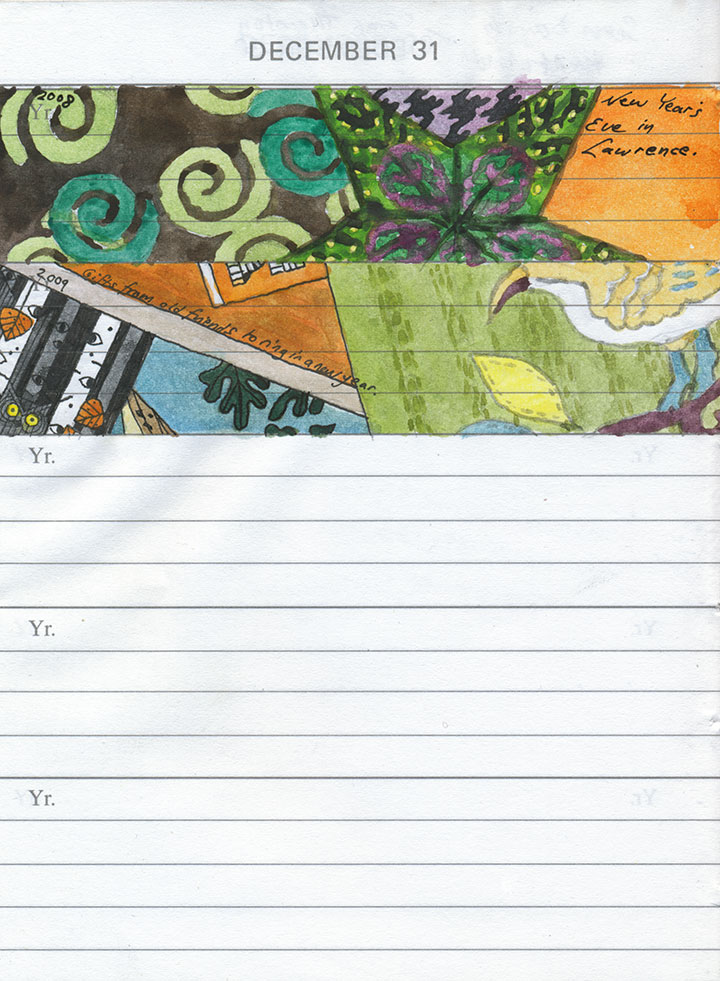
End-of-the-year summaries have never been my strong suit, not least because I tend to measure time on completely different terms than the standard calendar (like counting up from the anniversary of an important event, for instance). And since nobody seems to be able to agree on whether the decade ends this year or next (anyway, doesn’t any ten-year span count as a decade?), I think I’ll leave that one alone as well.
Instead, I thought I’d share my own way of marking time—an experiment that I’ve been working on for two years now.
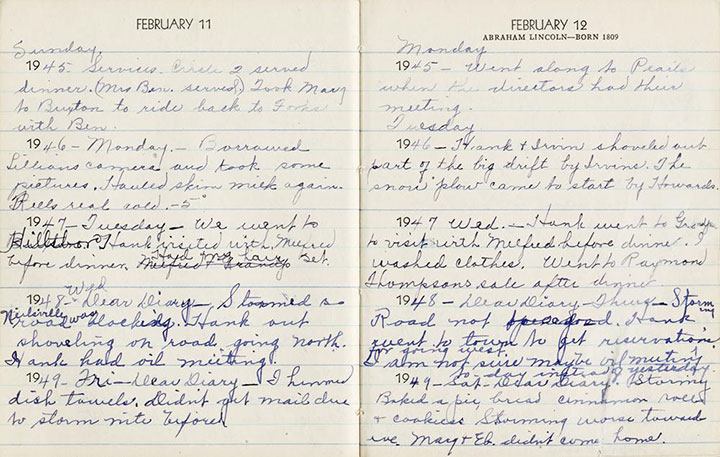
My friend Sarah Christianson has spent the last several years documenting the history of her fifth-generation family farm. Among her family artifacts are several of her great grandmother’s daily diaries, which Mrs. Anderson faithfully kept for many years. As you can see, there isn’t much space to write (so most entries say things like, “Went to the store, visited with Mildred,” etc.)—but what really interested me was how the five-year format of each page paints a larger picture of a woman’s life.

Sarah and I were both inspired to start five-year journals of our own, but I decided to turn mine into a sketchbook. I loved the idea and the challenge of documenting each day with a tiny, panoramic image.
Almost every drawing depicts something mundane, even trivial; it might be a sliver of that day’s activities, or just a snippet of an object that caught my eye. I’m almost never specific in the brief phrase written in each space—in fact, already I find myself forgetting what I was referring to when I go back to look at past entries. When I do remember what I was talking about, though, each illustration triggers my memories better and more richly than any of my photographs or writing can.
But that’s not the point of this project; this was never meant to be a detailed journal of my every thought or action. Instead, I’m trying to remind myself to really look at the world around me, and to live in my own present.
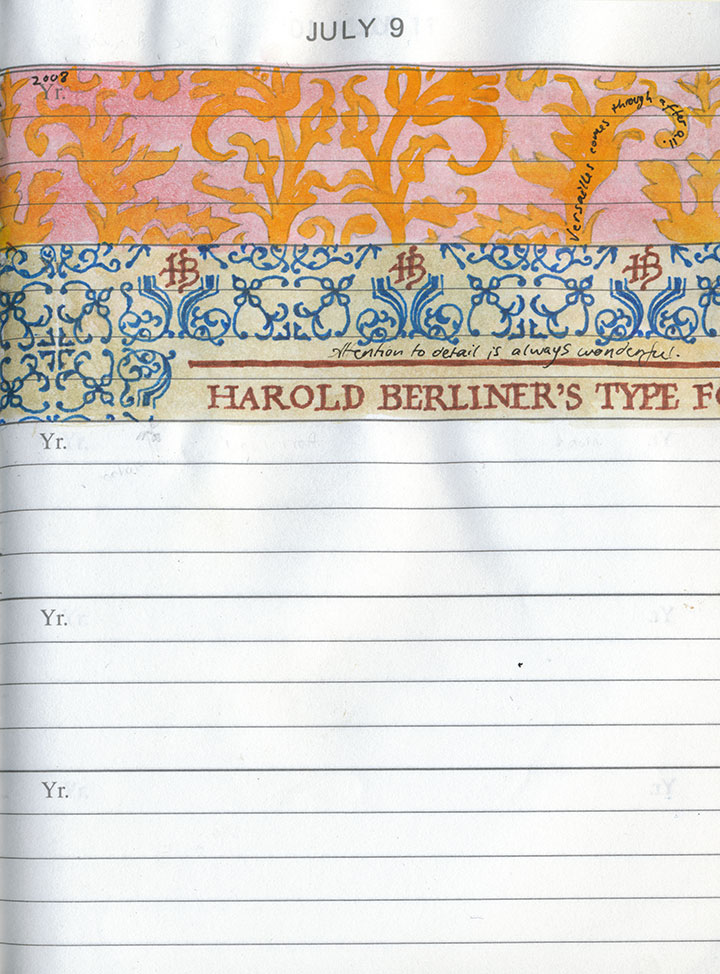
Now, exactly two years into the project, the same type of narrative I found in Claire Anderson’s diaries is already beginning to emerge. The drawings serve as a sort of flip-book; as one pages through the journal my personality, tastes and interests come to life, and the result is a more complete picture of myself than I ever could have come up with consciously. And an interesting by-product of all of this is the sometimes-unwitting documentation of the current era—this book might prove to be useful in other ways, someday.
The really curious bit is how the book is both intensely personal and completely ordinary. There isn’t a single image in there that I couldn’t share with a total stranger (no nudity, no embarrassing missives, no dirty laundry, etc.), and yet I’ve only actually shown it to a handful of people. I’m not sure why that is, but now that I’ve gone “public” about it I’m sure I’ll post occasional excerpts from here on out.
At the very least, maybe this will tighten the screws on my discipline a bit. Sarah and I learned quickly how difficult it is to keep a daily journal like this, whether in words or pictures (I doff my hat to Mrs. Anderson’s habits)—it’s all I can do to keep up with it, and I’m often playing catch-up. But now that I see how worthwhile the effort has been, I find myself excited for whatever tomorrow brings.
And isn’t that the whole point?
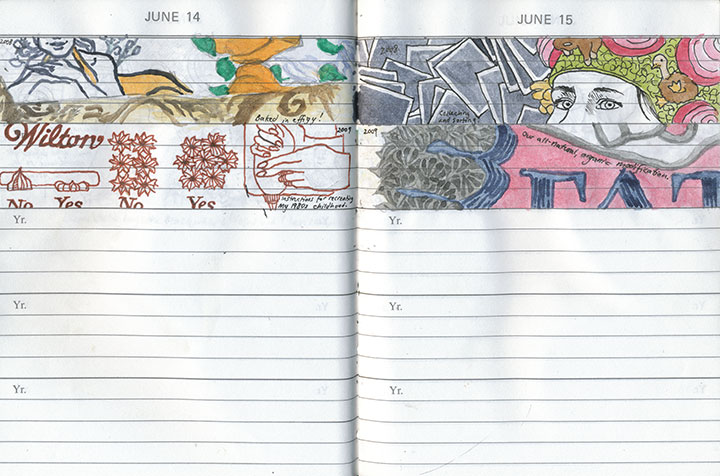
Wishing you a happy New Year full of wonderful events and tiny moments worth savoring—however you choose to remember them.
December 22nd, 2009
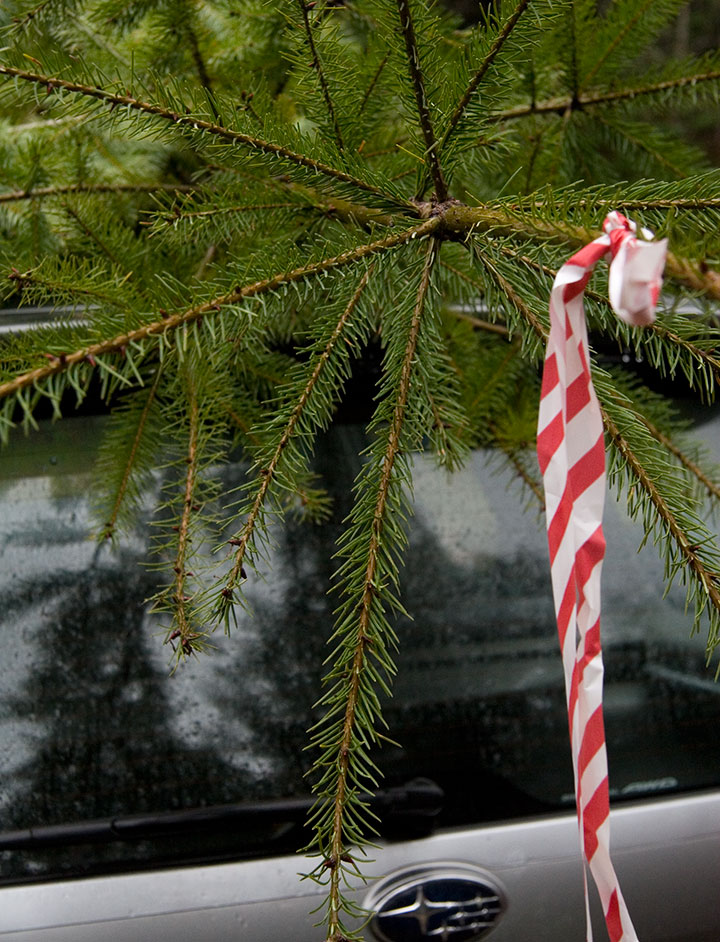
If you’ve been reading this blog for awhile, or you’ve met me or the Tailor, you already know about our penchant for storing food and taking seasonal eating to hardcore extremes. But our nuttiness about walking the talk extends far beyond the pantry. Another aspect of our attempts to live as sustainably as we can is our rejection of synthetic materials. Now, we’ll never live entirely free from petroleum products—we drive a car. We own a refrigerator, a stereo and a plethora of records, tapes, CDs and DVDs. I use a computer, a scanner, a digital camera, and a host of accompanying accessories. I’m not about to buy underwear with a button waist. I gleefully print with photopolymer plates. And we just can’t let go of our small, sentimental collection of deliciously hideous, ancient Tupperware. But all things considered, you’d be hard-pressed to find much plastic in our house. Whenever possible we buy clothing, tools, containers, furniture, and everything else made purely from natural materials: wood, metal, glass, cotton, linen, wool, silk, bamboo, cork, bone, shell. Much of the time, nowadays, that means we have to look for vintage versions of whatever we’re shopping for, but you’d be surprised at what’s available—as long as one is willing to search for it. I know how extreme this position is—and believe me, it’s not something that can be done overnight. This is a process years in the making, and just the fact that we’re still working at it (and probably always will) shows that it’s not for everyone, and certainly not the only solution out there. But the biggest benefit of it all is how long-lasting our belongings are—and when things break, they can usually be mended, rather than thrown away and replaced.
The biggest downside, however, is that by choosing this path we also choose to abstain from some creature comforts and cultural elements that are dated from after the advent of plastic. Most of the time I don’t miss it—or even notice anything lacking. But right now, during the holiday season, I have a fierce craving for twinkle lights that I just have to resist (if anyone can find me twinkle lights made entirely of glass bulbs, metal wire and cloth cord, I’ll be all over it).
Even with our solemn vows to thwart plastic, our search for a Christmas tree left us in some doubt (I grew up with an artificial tree, and have only had one Christmas tree of my own—a real one, three years ago). Is it better to buy a fake tree once or intentionally kill fifty-odd living evergreens in one’s lifetime? Which is worse—fossil fuels or deforestation? How about burning fossil fuels on our way to deforest a section of land?! (The irony of the freshly-killed tree tied to a hippie Subaru in the above photo isn’t lost on me.) And can one family really do so much damage just by celebrating the holidays, or should we just stop worrying so much?
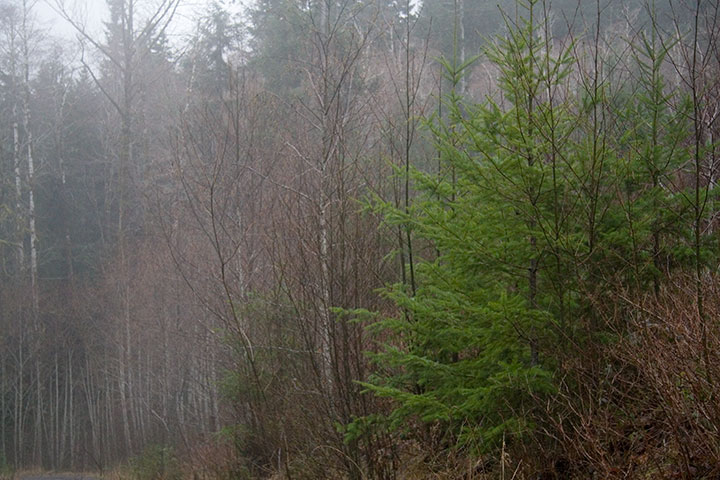
In the end, we followed the same instincts we rely on for our choice to remain omnivores: we decided on a real tree (after all, we do live in a place with abundant trees that shoot up fast, thanks to our rainy climate), as long as it could be culled responsibly. So we called up some friends who own land near Olympia, and as luck would have it, there were some young Douglas-firs on their property that were scheduled to be removed in the spring.
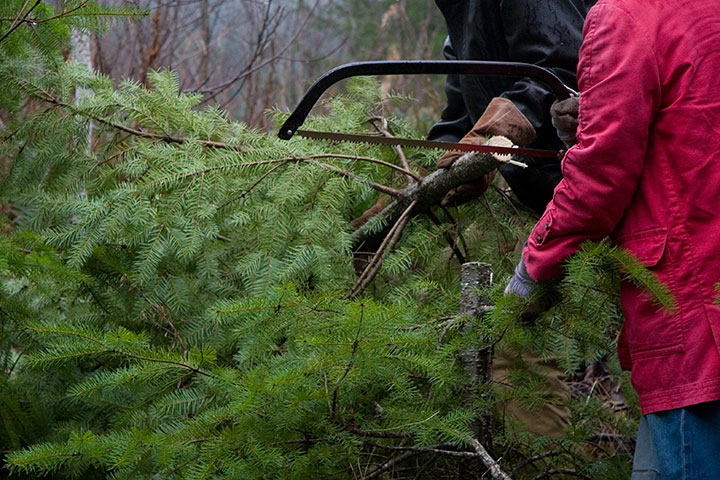
A little elbow grease later, we had our Christmas tree.
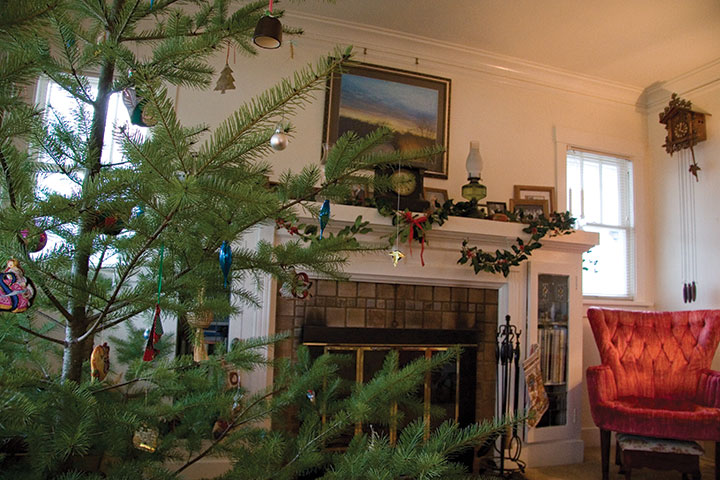
It doesn’t have the textbook perfection of a farmed tree, but it looks lovely in the living room, bedecked in handmade and vintage ornaments (I think there are exactly four plastic items contained therein). And as we decorated it on the solstice, I privately gave thanks to the land for contributing to our holiday.
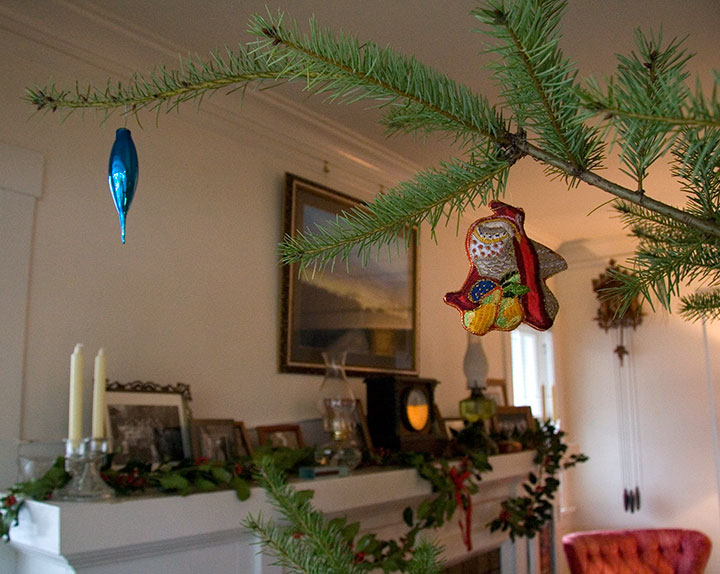
Now that we live in a house with a fireplace, we can finally hang the stockings by the chimney with care. And with a fireplace comes a mantel just begging to be decorated.
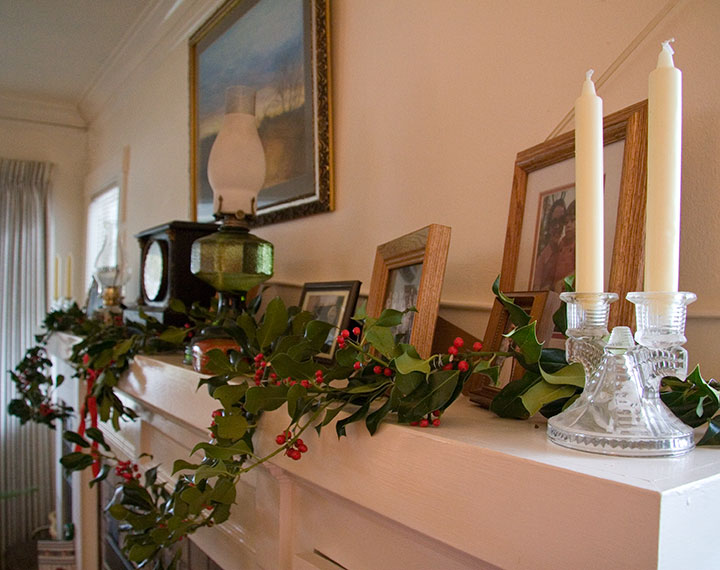
So another friend invited us to clip some holly branches (holly is a beautiful but noxious weed around here, so pruning is always welcome) from his back yard, and with the help of a little steel wire I whipped up a Christmas garland.
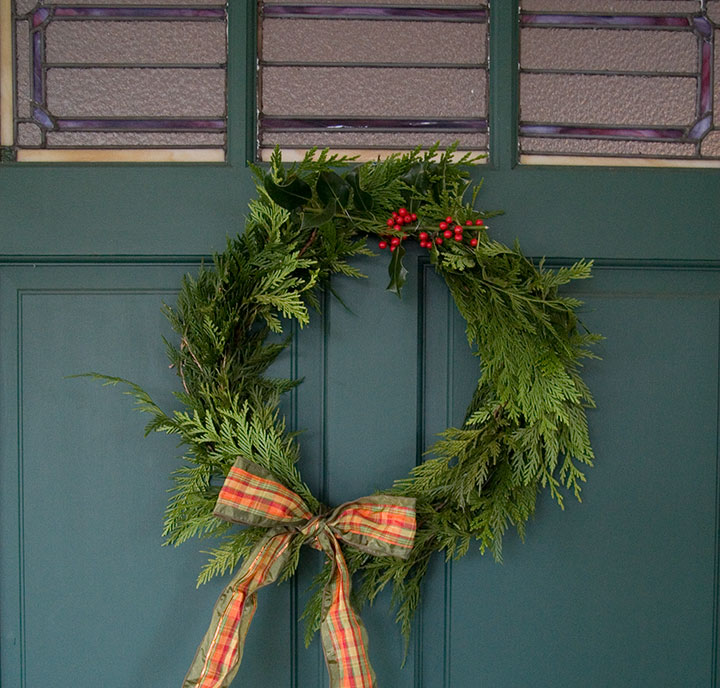
We used a bit of leftover holly and some cedar prunings for a wreath, and suddenly it was Christmas at our house. So maybe I don’t have my beloved twinkle lights, but somehow it feels better this way. We had a big holiday potluck last night, with thirty or so people crammed into our living and dining rooms, bellowing carol harmonies and exploding crackers and cheering when the Tailor poured blue-flaming brandy on the plum pudding. And nearly every one of them said it felt like their grandmother’s house, or their childhood traditions, or what they imagined of Christmases past. So maybe I don’t so much need that string of lights.
Still, since the moment we decided on a real tree I’ve been reminded of my favorite Robert Frost poem—which might make me all the more conscious of our choice, but also more appreciative of the holiday in general. After all, a Christmas tree is something the city “could not do without and keep its Christmas.”
Christmas Trees
(A Christmas Circular Letter)
The city had withdrawn into itself
And left at last the country to the country;
When between whirls of snow not come to lie
And whirls of foliage not yet laid, there drove
A stranger to our yard, who looked the city,
Yet did in country fashion in that there
He sat and waited till he drew us out
A-buttoning coats to ask him who he was.
He proved to be the city come again
To look for something it had left behind
And could not do without and keep its Christmas.
He asked if I would sell my Christmas trees;
My woods—the young fir balsams like a place
Where houses all are churches and have spires.
I hadn’t thought of them as Christmas Trees.
I doubt if I was tempted for a moment
To sell them off their feet to go in cars
And leave the slope behind the house all bare,
Where the sun shines now no warmer than the moon.
I’d hate to have them know it if I was.
Yet more I’d hate to hold my trees except
As others hold theirs or refuse for them,
Beyond the time of profitable growth,
The trial by market everything must come to.
I dallied so much with the thought of selling.
Then whether from mistaken courtesy
And fear of seeming short of speech, or whether
From hope of hearing good of what was mine,
I said, “There aren’t enough to be worth while.”
“I could soon tell how many they would cut,
You let me look them over.”
“You could look.
But don’t expect I’m going to let you have them.”
Pasture they spring in, some in clumps too close
That lop each other of boughs, but not a few
Quite solitary and having equal boughs
All round and round. The latter he nodded “Yes” to,
Or paused to say beneath some lovelier one,
With a buyer’s moderation, “That would do.”
I thought so too, but wasn’t there to say so.
We climbed the pasture on the south, crossed over,
And came down on the north.
He said, “A thousand.”
“A thousand Christmas trees!—at what apiece?”
He felt some need of softening that to me:
“A thousand trees would come to thirty dollars.”
Then I was certain I had never meant
To let him have them. Never show surprise!
But thirty dollars seemed so small beside
The extent of pasture I should strip, three cents
(For that was all they figured out apiece),
Three cents so small beside the dollar friends
I should be writing to within the hour
Would pay in cities for good trees like those,
Regular vestry-trees whole Sunday Schools
Could hang enough on to pick off enough.
A thousand Christmas trees I didn’t know I had!
Worth three cents more to give away than sell,
As may be shown by a simple calculation.
Too bad I couldn’t lay one in a letter.
I can’t help wishing I could send you one,
In wishing you herewith a Merry Christmas.
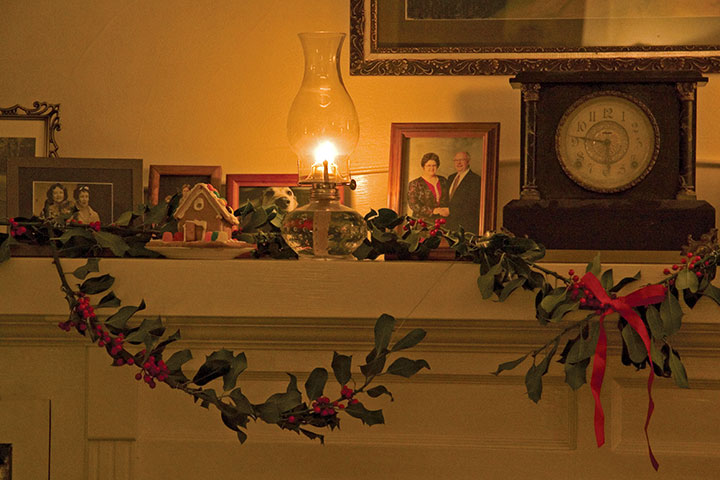
November 27th, 2009
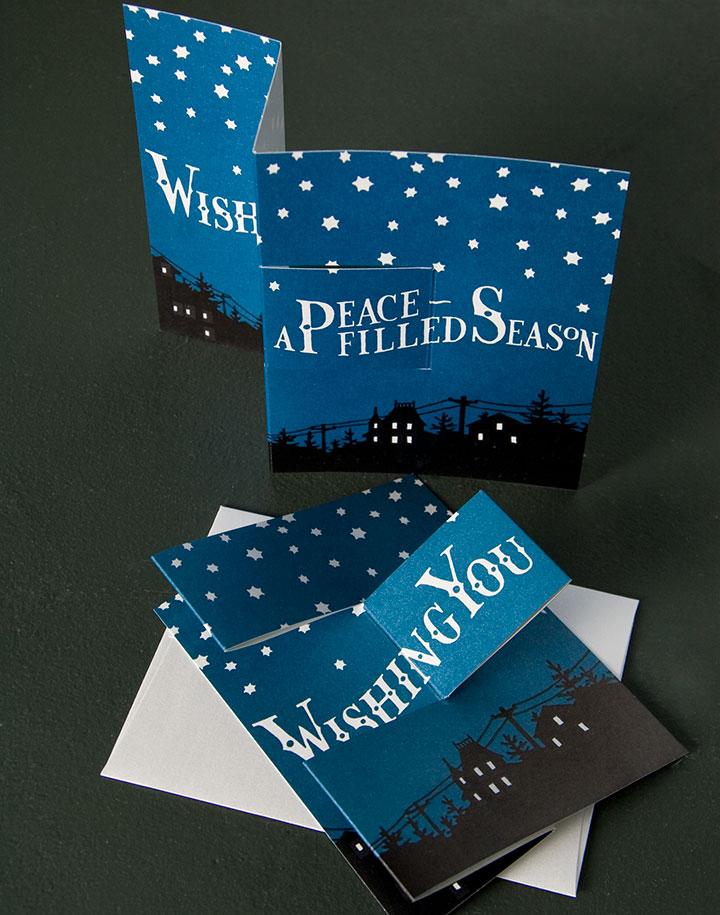
Every year I make a resolution to create a whole slew of greeting cards for the holidays, and every year I’m lucky if I can scrape together one postcard design to send to my own friends and family. Maybe it’s because I’m not really capable of getting in the mood for Christmas or Hanukkah in July, but by the time November rolls around and I finally think of it, there never seems to be enough time. Good thing I have my friend Allison to think of these things.
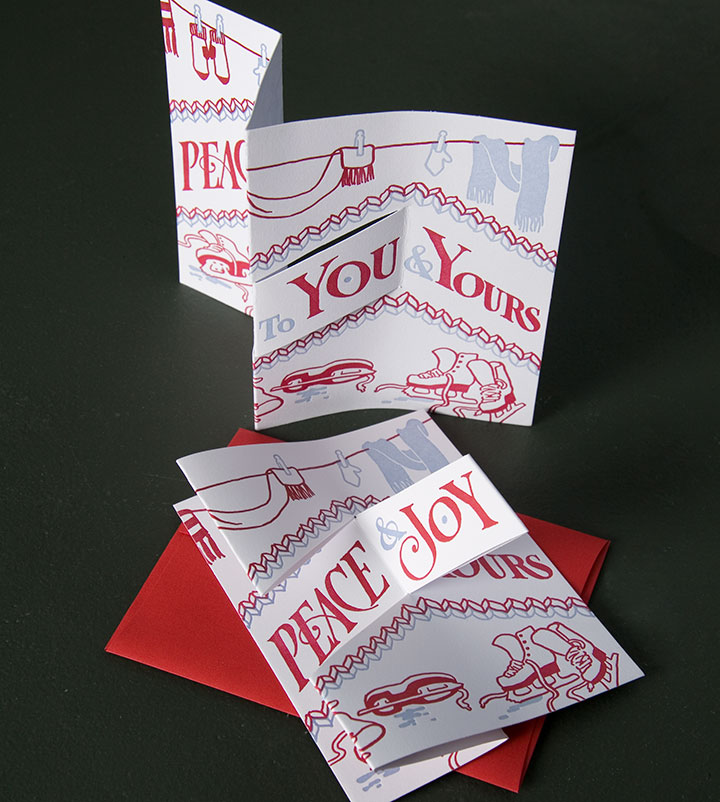
Allison Chapman runs Igloo Letterpress, a lovely little shop in Worthington, Ohio. She called me up this summer and asked me if I’d like to start a line of letterpress cards with her—since neither of us had time to do both the design and the printing, it was a match made in heaven.
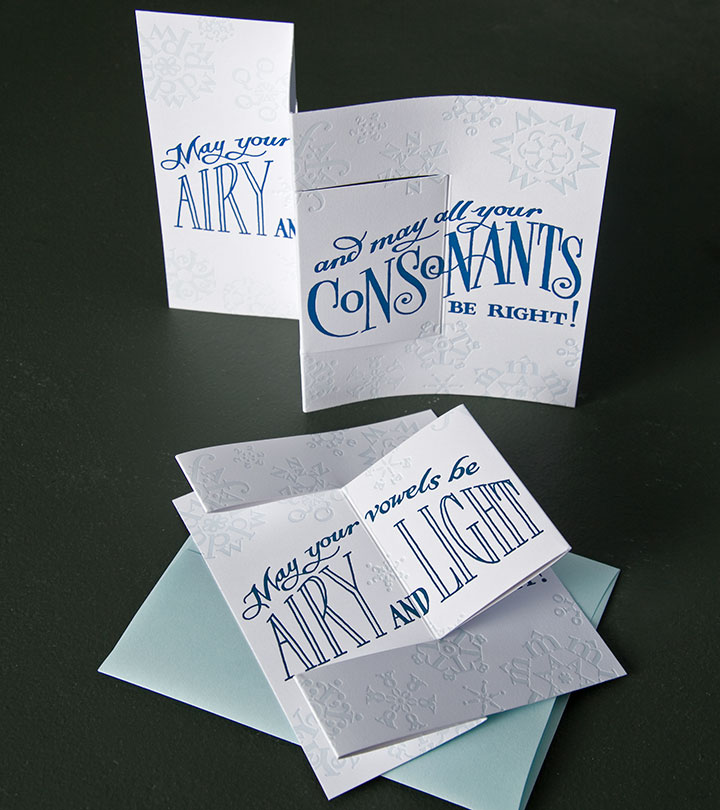
Collaborating when you have a couple thousand miles between you can be quite a challenge—especially when you’re trying to reinvent the wheel a bit. But Allison and I were on the same wavelength from the first moment, and it was so easy to leave the printing in her capable hands. Besides, her ideas for 3D pop-up cards turned out to be perfect for letterpress. Each of these cards is a kinetic greeting, with a unique folding structure that delivers the message in an unexpected way. And as always, the illustrations are created from hand-lettered type and hand-drawn patterns and imagery (as if you hadn’t guessed).
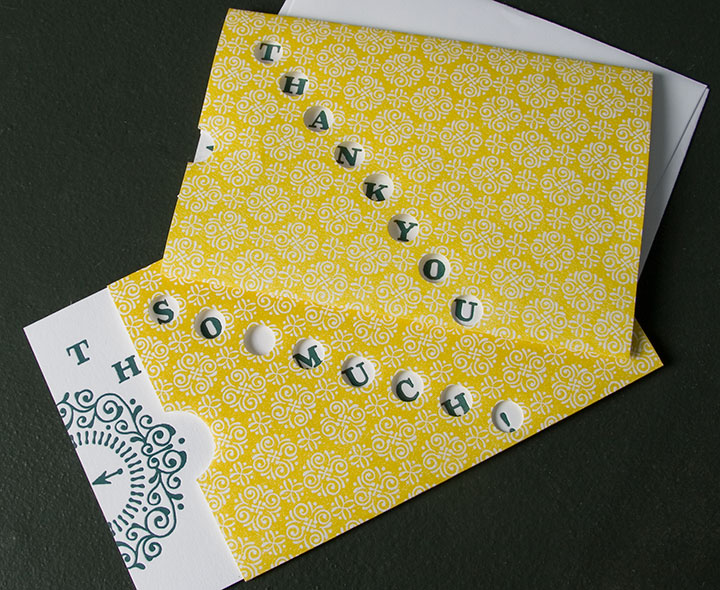
And for after the holiday gifts are opened, we threw a thank-you card into the mix as well. Instead of a pop-up piece, this card slides out of a die-cut sleeve to reveal the whole story.
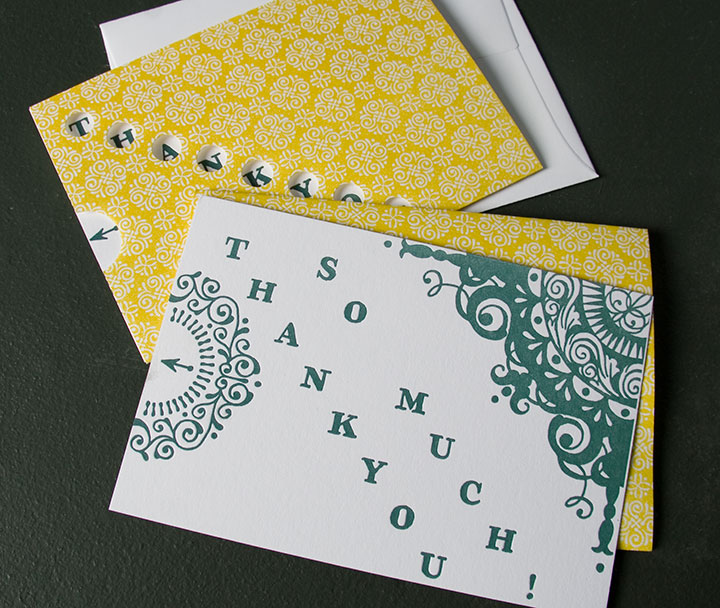
All of these cards come with a standard A2 envelope, and are available either individually or in packs of six.
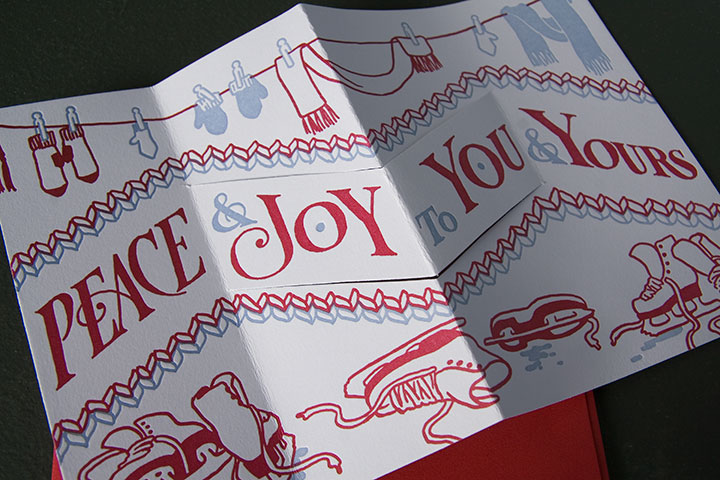
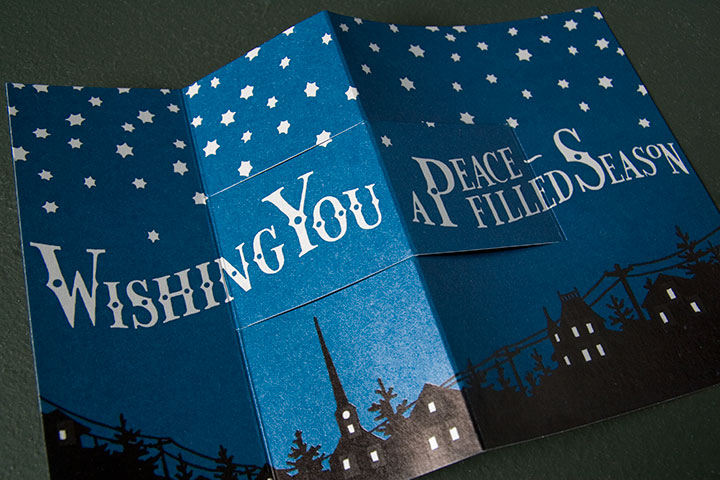
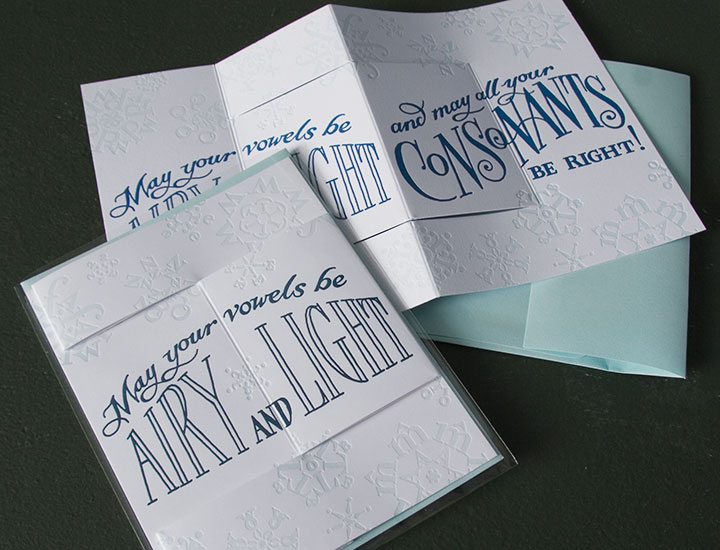
For more images and ordering information, visit the shop.
One last thing: many thanks to the wonderful Sarah Christianson for sweeping in with her professional lighting and photographing the cards for me! Happy holidays!
November 26th, 2009
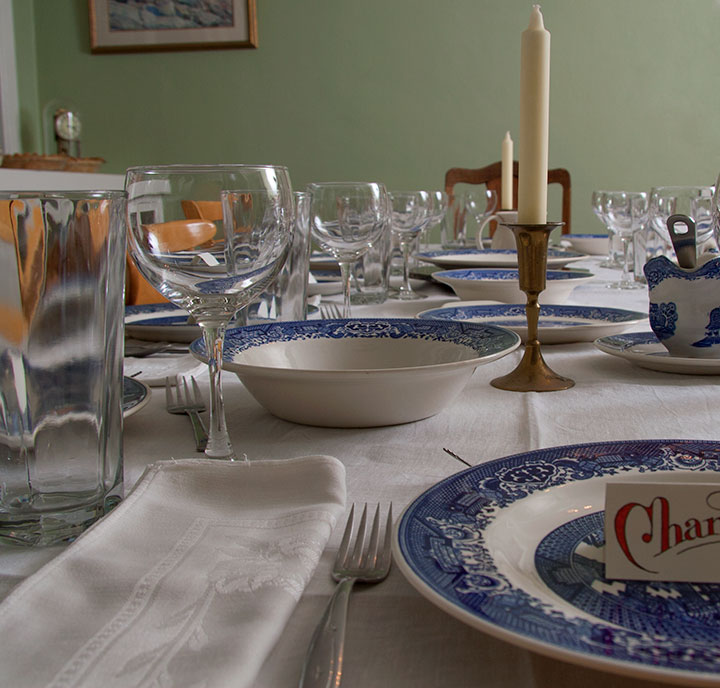
Today I am thankful for the new and old friends who surround me today; for the contrast between the wet Northwestern chill outside and the cozy warmth inside; for the beauty that is so easy to find ’round these parts; and for you. Thank you for joining me here in my little virtual space.
Happy Thanksgiving.
November 10th, 2009
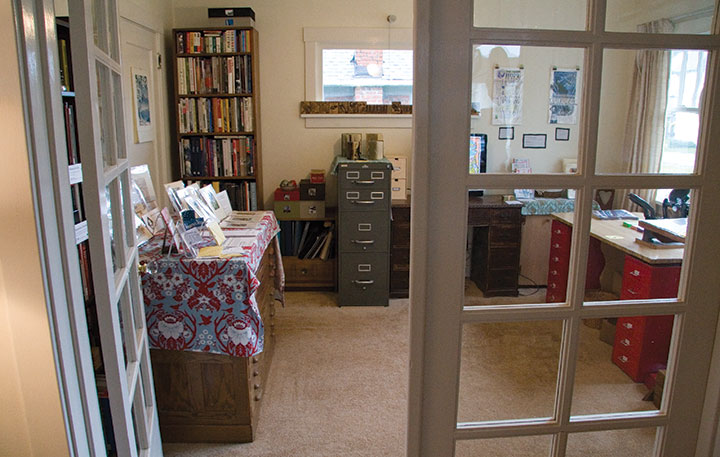
Yowsa! When Tacomans say they’re into art they’re not kidding. Despite absolutely horrendous weather, we had 130 visitors to the studio this weekend! (Hmm…which, oddly enough, is almost exactly the square footage of the space. This is how things looked before that first knock on the door Saturday.)
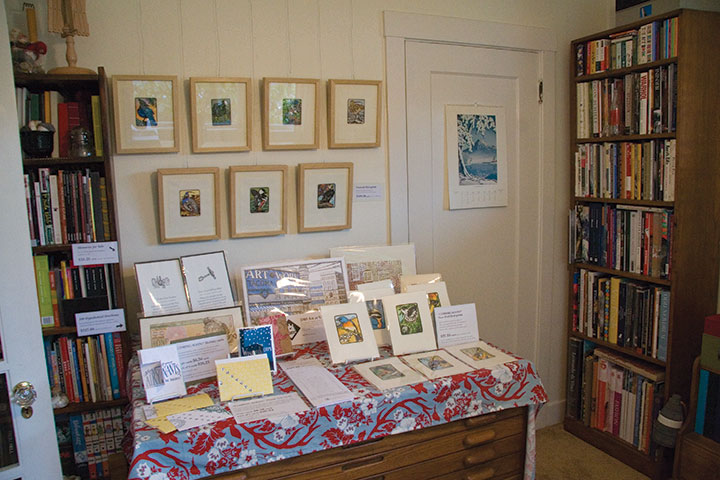
So a vast, colossal thank you is in order for all of you who braved the downpour and jet-propelled ice pellets to get here, and then shoehorned yourselves into the studio to order prints, start a subscription, get your hands dirty on press, or just say hello (sorry the Tailor’s fabulous cookies ran out so quickly). Friends stopped by for a quick hug, gaggles of kids discovered the joys of printing, and one person immediately ran out and bought her own Kelsey press that very same day (you know who you are!), courtesy of Tacoma’s Antique Row. Lots of people returned the second day, and I lost count of all the newcomers and fresh faces. Everybody came with intelligent questions and thoughtful insight, and I’m just overwhelmed by all the kind words of welcome and encouragement. And as if that weren’t gratifying enough, when we finally closed up shop on Sunday, everything was just as tidy as it was on Friday night—no mud tracked in, no prints out of place, no ink straying beyond the demo table. You people are amazing! Sign me up for next year.
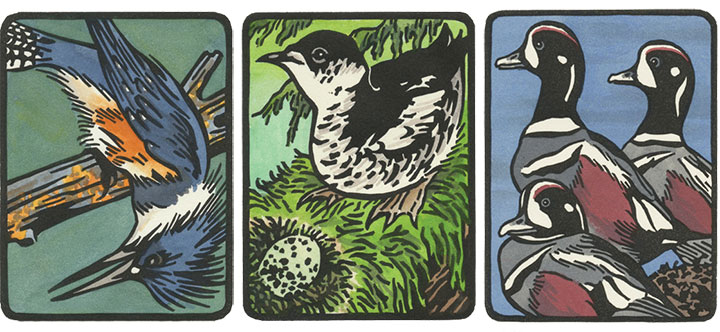
In the meantime there’s still quite a lot of finishing-up to do before the holiday rush consumes my brain (I’m still not over the weird sensation of being on the other end of holiday retail). I’m going to hold onto Marie Curie until Thursday so I can tie up some other loose ends first, so look for it online then.
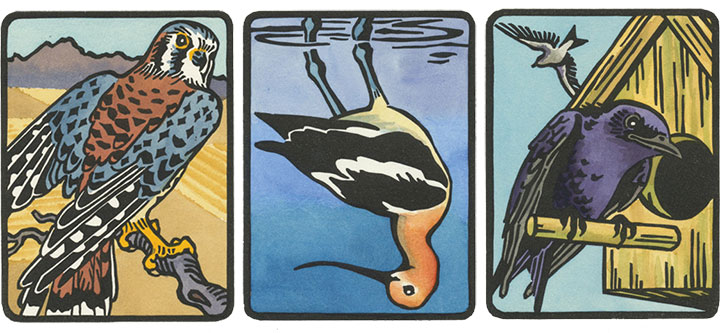
For now, here’s a quick peek of the new birds that were unveiled this weekend. I’m still finishing up the editions (you should see my little watercolor assembly line), so if you placed an order at the studio tour, I’ll be contacting you in the next couple of weeks.
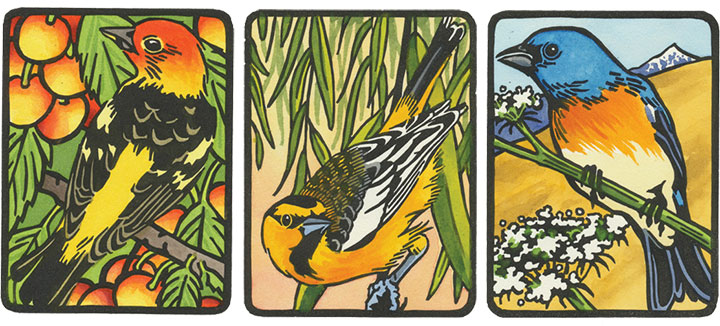
If you’re local but you missed out on the tours this weekend, these little guys will be available at the next Tacoma is for Lovers Craft Fair, held at the inimitable King’s Books on Sunday, November 22, from noon to 5 pm. And for the online world, I’m posting them one-at-a-time, every couple of days in the Etsy shop—just so I don’t get too far ahead of myself!
November 5th, 2009
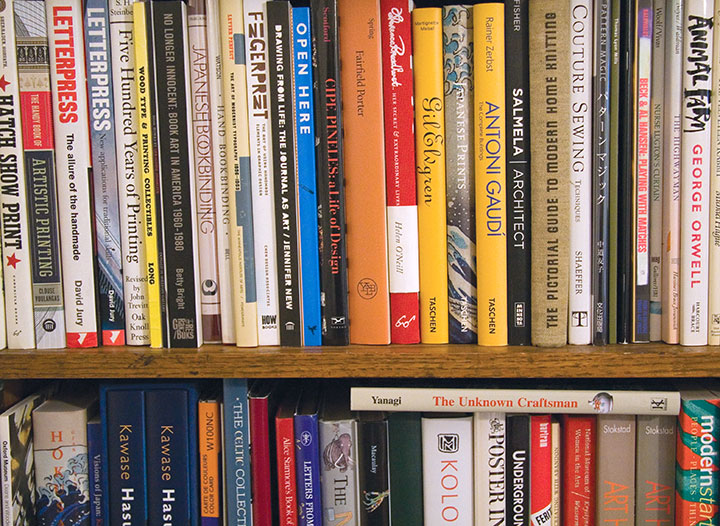
One of the biggest highlights of Tacoma’s annual Art At Work Month is the huge, city-wide Studio Tour circuit, when artists of all stripes (painters, sculptors, printers, photographers, dancers, weavers, jewelers, glassblowers, etc.) open their work spaces to the public and share their processes and products. This year (the eighth year of the event!) there are 39 stops on the tour, and yours truly is joining in on the fun.
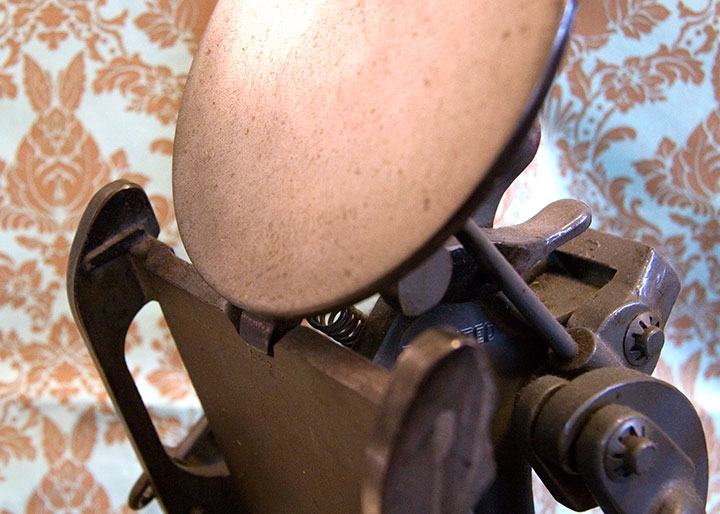
I’ll be firing up the little Kelsey press, so stoppers-by can print their own keepsake and catch the letterpress bug (watch out, it’s contagious!),
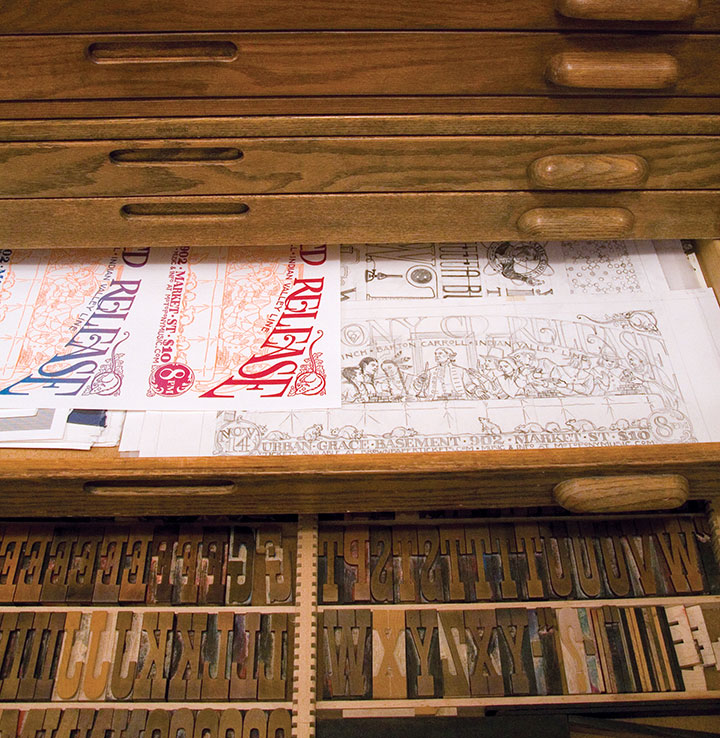
and I’ll have lots of sketches, layouts, tools, and other process materials on display. This is the best part for me, since letterpress and artist books always bring up a lot of questions, and this time I’ll have plenty of visual aids at hand.
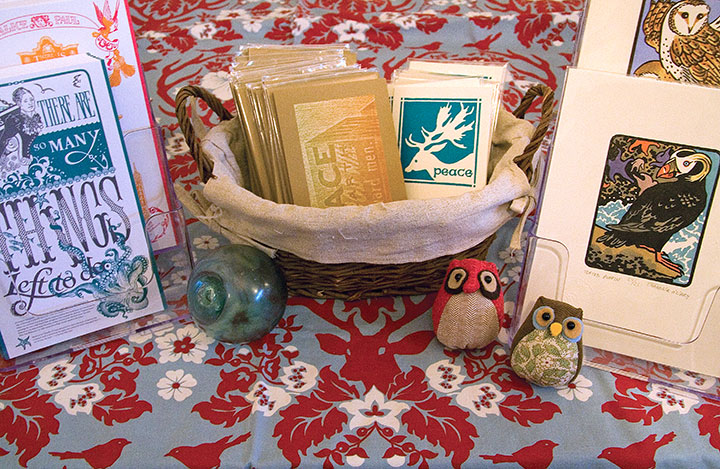
(Stuffed owlets by Mirka Hokkanen, another studio tour artist!)
And since the holidays are just around the corner (or already here, if you believe the Christmas muzak blaring at the grocery store; I proudly promise that Anagram Press will be a carol-free zone), there will be all kinds of goodies for sale, including a boatload of brand-new items. I’ll have copies of the Art At Work poster, a preview of nine (!) new bird prints and several holiday card designs to pre-order, and the unveiling of the newest Dead Feminist broadside. Jessica and I are featuring Marie Curie and the issue of health care this time—but that’s all we’ll share for now. Look for photos and details online next week, but if you want a head start and first pick, you’ll have to come to the tour!
Jessica will be on the tour circuit, too, at her magnificent studio Springtide Press—where she’ll be manning the Vandercook, churning out all kinds of surprises.
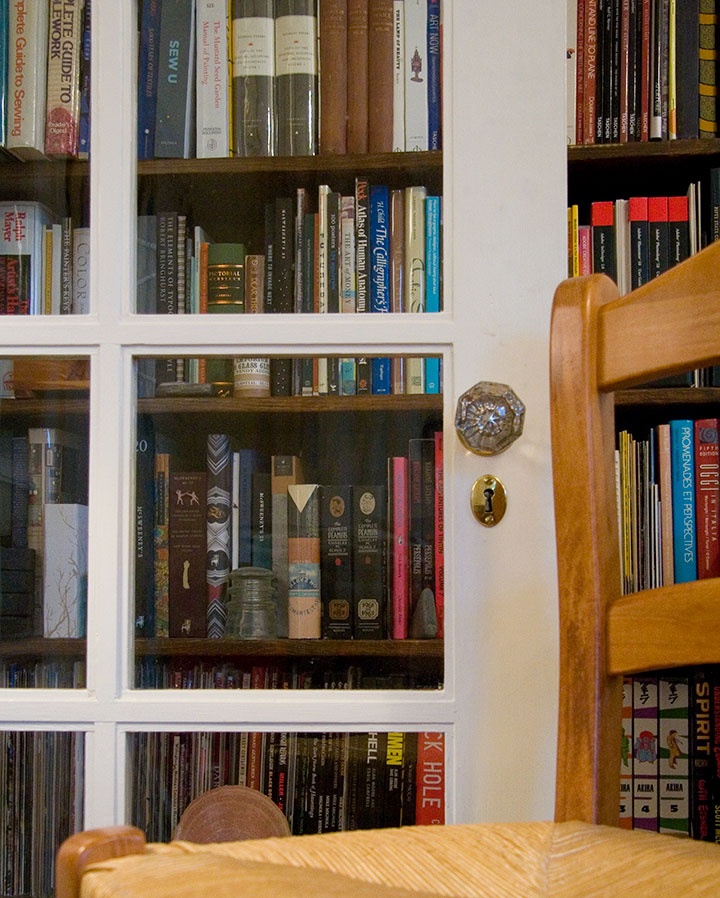
So grab an umbrella, ’cause it’s going to rain (are you surprised?), and take a walk around the neighborhood—Anagram Press and other participating studios will be open from 10 am to 4 pm, this Saturday and Sunday, November 7 and 8. And best of all, the event is free and open to everyone! This is my first time participating in the Studio Tours (Alec Clayton from the Weekly Volcano included me in his list of “must-see studios,” so now I’m officially nervous), so please bear with me while I work out the kinks of hosting a hundred or so guests in my little space—I’ll do my best not to run out of munchies or keepsakes. Come on by and say hello.






![Chandler O'Leary [logo]](https://chandleroleary.com/wp-content/themes/chandleroleary/images/logo.png)

























































